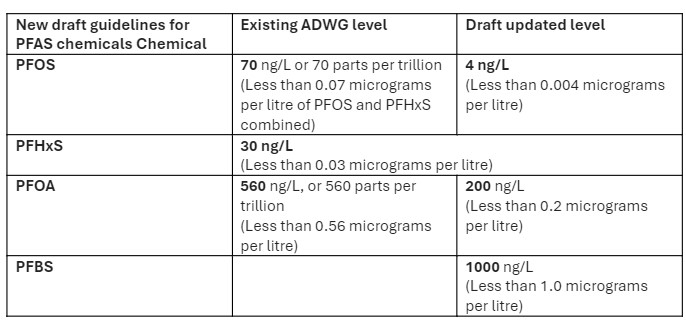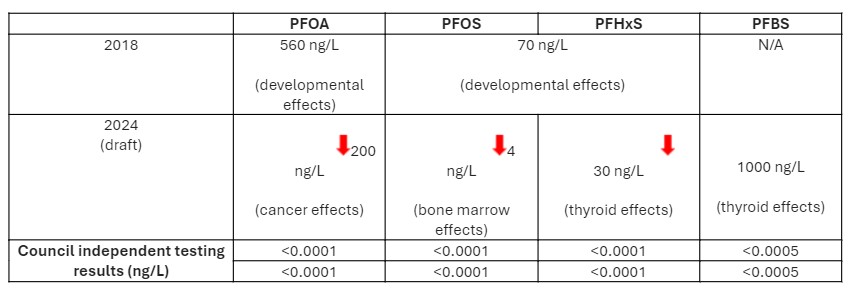Water Quality
Draft Guidelines for PFAS
Lithgow City Council has welcomed the release of the draft updated Australian Drinking Water Guidelines on PFAS by the National Health and Medical Research Council (NHMRC).
The draft guidelines propose health-protective levels for four PFAS:
- lower levels for the three types of PFAS in the current guidelines (PFOS, PFOA, PFHxS)
- a new level for an additional PFAS chemical – PFBS.
PFAS chemicals have been manufactured in the United States, Europe and Asia since the 1950s. Though not made in Australia, the chemicals have been widely used here in industrial and consumer products such as firefighting foams, pesticides, fertilisers, carpet, paint, frying pans, make-up, sunscreen, clothes, food packaging and other everyday items.
PFAS chemicals are not added to drinking water, but very small amounts can be present in water due to contamination from external sources in the environment and these consumer products.
New draft guidelines for PFAS levels in Australian Drinking Water Guidelines
The National Health and Medical Research Council (NHMRC) has released updated draft Australian Drinking Water Guidelines values for four types of PFAS chemicals in Australian drinking water. The guidelines indicate how much PFAS in drinking water a person can consume over their lifetime, without any increased risk to their health.
The NHMRC is an independent statutory body made up of Australia’s leading expert body in health and medical research. It is made up of State and Commonwealth Chief Medical Officers, public health officials and other medical professionals. Its review of the guidelines is led by a committee of independent experts in the areas of water quality, water chemistry, microbiology, toxicology, and other leading scientists. The review process for PFAS has been taking place since 2022.
State and territory-based health authorities and water utilities follow the guidelines and set testing and treatment practices across treated drinking water sources.
NHMRC indicated that concentrations of PFAS below the proposed guideline values would not be expected to result in any significant risk to health over a lifetime of consumption. Short-term exposure to higher levels of PFAS is unlikely to change this risk. The draft guidelines are health-protective and include assumptions appropriate to the Australian context. The health-based guideline values are very conservative, and include a range of uncertainty factors, which always err on the side of caution.

Council recently undertook testing of the water supply and in the reticulation with NSWHealth to understand the potential PFAs contamination in the water system. The testing undertaken showed that Council’s water supply system across these two tests was well below not only the current Australian Drinking Water Guidelines but also the proposed draft guidelines from the National Health and Medical Research Council.

Response to recent media regarding Chemical Concentrations in Lithgow Drinking Water conducted in 2011
Lithgow City Council has responded to recent media regarding the presence of Per and polyfluoroalkyl substances (PFAs) compounds, in particular perfluorooctanoic acid (PFOA) and perfluorooctane sulfonate (PFOS), detected in a 2011 study of water supply systems across NSW.
“This Council provides a safe and secure drinking water supply. Water utilities, like this Council, are tightly regulated. Lithgow’s water supply is tested to ensure that it adheres to the Australian Drinking Water Guidelines.” said General Manager, Craig Butler. “The Council undertakes water quality testing daily, weekly, monthly, and quarterly depending on the requirements of NSW Health.” said Mr Butler
A recent media article referenced a 2011 study, Concentrations of PFOS, PFOA and other perfluorinated alkyl acids in Australian drinking water (2011), from Thompson et.al. This study detected six compounds in a single sample from a single property in the Lithgow area. The concentration results from this survey were well below the current Australian Drinking Water Guideline values.
The article makes comparison to the United States Environment Protection Agency (EPA) drinking water safety thresholds. The United States EPA sets a Maximum Contaminant Level at 4 parts per trillion or 4 nanograms per litre (4ng/L) for PFOA and PFOS individually.
“The Australian Drinking Water Guideline for PFOS is less than 70ng/L, and PFOA is less than 560ng/L. The results in the sample from Lithgow 13 years ago was less than 0.5ng/L (PFOA) and 0.76ng/L (PFOS) respectively.” noted Mr Butler
“I assure the community that the Council continues to test Lithgow’s drinking water supply to ensure adherence with the current guidelines and directions of regulators.” concluded Mr Butler
The appropriateness of these guidelines is monitored by NSW Health and the National Health and Medical Research Council.
The Council further acknowledges community concerns and wishes to dispel misinformation that is currently being circulated through social media and other means as follows:
How often does the Council test for these chemicals?
Drinking water quality is tested daily locally, and then weekly by NSW Health labs and finally monthly by Sydney Water labs to ensure EPA compliance. This testing meets the requirements of NSW Health and the NSW Environment Protection Agency. Council is not currently required to test for Per-and polyfluoroalkyl substances (PFAs) compounds in its drinking water under the current guidelines.
Are these Chemicals in the water due to the power stations?
The study does not discuss the potential source of the chemicals.
Is Lithgow on the list because of the chemicals required to fight the horrific bush fires?
The study does not discuss the potential source of the chemicals.
Is Lithgow drinking water safe?
Lithgow’s drinking water complies with the Council’s Drinking Water Management System, and the guidelines and directions from NSW Health and the Department of Climate Change, Energy the Environment and Water. NSW Health do not require the Council to test for PFAs and its compounds as an ongoing test.
Does boiling water remove these chemicals?
No. PFAs and their associated compounds are non-soluble meaning they do not break down in water over time. The only effective method to remove the compounds has been shown to be through Reverse Osmosis treatment and Activated carbon filtration. Peer-reviewed articles on the treatment processes to remove PFAs compounds and chemicals are available online for interested parties.
The report is from 2011, how have council worked to reduce these chemicals since then?
Council carries out ongoing works across the water network to ensure the system is safe and secure from pollutants and hazards. This includes the upgrade and replacement of filtration units at the Oakey Park Water Treatment Plant and ongoing upgrade works at the Duckmaloi Water Filtration Plant.
Links to related information on this matter
Statement from the industry peak body Water Services Australia which has also responded to the SMH story PFAS and drinking water in Australia | Water Services Association of Australia (wsaa.asn.au)
The Water Services Association of Australia fact sheet can be found here Per- and Poly-Fluoroalkyl Substances (PFAS) Fact Sheet | Water Services Association of Australia (wsaa.asn.au)
Water Quality
Lithgow City Council will notify customers of any water quality issues as soon as we become aware of them.
Customers who use large quantities of water or who are highly dependent on water, such as dialysis patients and businesses, are notified directly. Other customers are notified via community announcements and our website.
If you think you have an issue with your water quality we ask that you call us on 02 6354 9999 or visit our website.
Our comprehensive monitoring and maintenance program ensures our customers and consumers enjoy the highest quality water. However, external factors can sometimes alter water quality causing:
- discoloured water
- algal bloom
- white water
- blue water
Discoloured Water
Discoloured water looks brown or muddy and can stain when washing. It is an irregular occurrence caused mainly by the natural element, manganese.
While water may look brown, it will not cause people to become ill if consumed. Manganese levels up to 0.5 mg/L are safe to drink. If you receive brown water, generally it will maintain manganese levels of less than 0.5 mg/L – and is therefore safe to drink.
Manganese collects on the inside of pipes. During times of high demand or changes in flow, these films can loosen, causing water to appear stained or dirty. We prevent the problem at our water treatment plants and undertake substantial flushing of the pipe system in affected areas.
If discoloured water is present, it can stain clothes when washing. During times of discoloured water we suggest residents delay washing clothes. If this is not possible, we recommend:
- running some water into the machine to check the water colour before washing clothes
- check the water colour before the washing machine reaches the rinse cycle – as it is at this stage that clothes can be stained.
What should I do if the washing gets dirty?
If your load of washing is dirty or stained, you should keep the washing completely wet, and not hang it out. If you have a nappy stain remover then the affected washing should be soaked and washed as directed, as they often can remove the stains once the water has been cleared.
Some washing powders cause the pH level of the water in the washing machine to increase, and this has the effect of causing manganese or iron in the water to come out of solution and to stain the washing. Also, powders high in phosphorus can also have the same effect.
A good quality liquid dishwashing detergent can also help remove dirty water stains.
Algal bloom
Blue-green algae (or cynobacteria) is responsible for many of the algal blooms in Lithgow’s recreational waterways during the past few years. Blue-green algae feeds on nutrients washed into waterways, or from nutrients released from sediments.
Algal blooms are likely to form when:
- the water is relatively still
- nutrients levels are high
- temperatures remain warm
- after a period of high rainfall that results in nutrients being washed from the catchment into the dam
Although algal blooms are very rare in Farmers Creek Dam water supply, our water treatment plant using a combination of flocculation, filtration and chlorination is highly effective in treating water affected by a bloom, making it safe and palatable to drink.
White water
Milky or cloudy appearance is usually due to tiny air bubbles in the water. This can occur when air is trapped in the pipes after they have been repaired, or if carbon dioxide is released by the sudden reduction in pressure with a tap discharging.
Air in water is harmless and a glass of white water left standing will quickly clear.
Blue water
Blue water may have a cloudy, blue tinged appearance. It can taste bitter and metallic. In most cases it comes from copper pipe that has not been used for some time and has become slightly corroded.
Blue or green water may contain high levels of copper and should not be used for drinking or food preparation.
While blue water is potentially serious, the solution is simple. Flush the affected taps for one to two minutes before use. Testing shows that within seconds of flushing, copper levels drop to well below guideline limits.